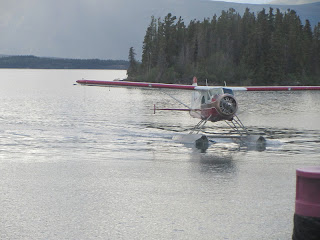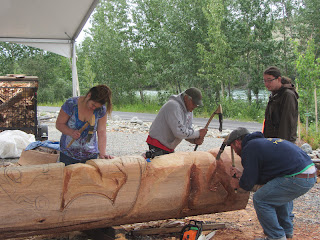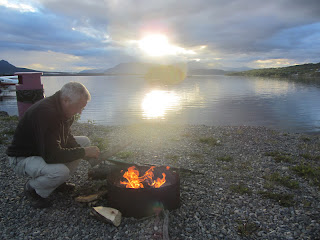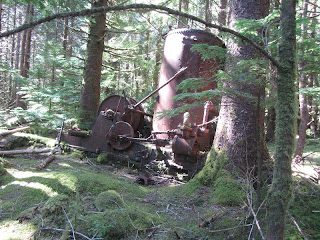It seems so long ago that we were in Whitehorse and our travels and family reunion since then have been as wonderful and full as we could ever imagine. I will attempt to get to where we are now (water side of Alaska) in the next few blogs.
Whitehorse is nestled in a valley and surrounded by a low mountain range. The mighty Yukon River flows through the middle of the city and I could not take my eyes off of it as it sped northward. I had the same sensation as I get when I stand beside the brink of Niagara Falls.

 |
| Beautiful statue |
 |
| Heading into Whitehorse |
 |
| Interesting yard art |
 |
| The best lunch ever! |
 |
| Relics at the campground, left from the building of the Alaska Highway |
 |
| The Centre |
 |
| Inside looking out |
 |
| When the Canadian government "gave" the land title to the First Nation people, an elder commented "You are giving us nothing; you took it away from us years ago" |
Wayne told us that he became an alcoholic when he was quite young in Alaska. He married and had sons and knew that he needed to change his path. Although he participated in sweat lodges many times to seek his direction, he was unsuccessful for years. Finally, 6 years ago, he participated in a particularly gruelling sweat that lasted beyond anything he'd ever done. He said that when he was close to passing out with the fasting, dancing and praying, his creator came to him and told him that he must use his skill as a carver and teach the young the ancient skills and that he must also heal the generations that follow him. He took his idea of building a healing canoe out of a single log that he felled himself, to his elders and they supported him. He brought together young people and money to fund the project. His first attempt resulted in his money and canoe being stolen. Wayne found little support from his community and he heard that the First Nations people of Whitehorse were not only interested in his ideas, they were prepared to support him in any way possible.
His first project in Whitehorse, was to build the Healing Canoe he had hoped to carve in Alaska. We saw the end result through the window of a building that wasn't yet opened and it is beautiful. It was created to raise awareness of and bring an end to spousal abuse. One side of the canoe has a beautiful woman's hand and the other, a man's. He said that when his creator spoke to him about what he needed to do, he said "when you hear the children sing by the river, you will know that you are healing and will not return to your past". 17 young people who had never carved before, worked day and night and completed the vessel in record time and when it was finished, they carried it on their shoulders to the Yukon River for a ceremonial paddle, and Wayne was completely blown away when they all began to sing. I was overcome with emotion and tried not to look at him (we were all facing the totem at that time) and finally he addressed me and he saw the tears pouring down my face. His throat caught and he began to cry as well.
The Healing Totem they are currently carving is to begin to heal all of those who suffered in the residential school system or anyone of any colour or belief, who has suffered any abuse, anywhere in
the world. The raising ceremony will be sometime in late August or early September and he invited us to return and take part. It just might work for us as we make our way south from Alaska. As we drove away from Whitehorse, we both felt happy and drained and Bob commented that it was the most special experience of the trip so far.
 |
| Wayne Price If you could read the words on his sleeve, you would see "Sober Native" |
 |
| Leaving Whitehorse and the most common sight on any of the roads we've travelled |
 |
| Back in BC and headed to the most beautiful little town, Atlin...population - 400, so tiny and yet it is host to one of the largest music festivals in Canada each summer. |
 |
| Crazy looking ducks in the glacial water in front of our campsite |
 |
| We loved the design of this home |
 |
| ...and from the front |
 |
| Original architecture |
 |
| Atlin Air Medical Service |
 |
| Atlin Lake is glacial fed from the only mountain island in North America. It stands alone and spills it's cold, clear and pure water into this basin and this best kept secret town. |
We met a fun couple from Vancouver, the only other campers in the little campground. Lynn is Irish and her husband, Malcolm is Scottish. We sat around the campfire until the wee hours. They had discovered the local pub early in the afternoon and managed to get a little tiddly with the locals and so our time with them was outrageous and hilarious. They've invited us to stay with them when we get to Vancouver.....I wonder if they remember....
 |
| Dipsy-doodling back and forth between BC and Yukon |
 |
| Along the way... |
 |
| Our fabulous campsite back in BC |
 |
| An up close and personal view of lunch for this big guy |
 |
| Glaciers so close on the way to Steward, BC |
 |
| There had been so much rain in this part of BC that the bridge had washed out (see the water level off the end?) and we had to cross the raging river on a bailey bridge |
It is a really busy waterfront with fishing vessels, kayakers, yachts and cruise ships coming and going. We found a great pub (where else?) that overlooked the harbour where we could watch the entertainment of fishermen cleaning their catch and the crazy shuffling that was necessary to get the watercraft in and out of the harbour.


 |
| Fledgling eagle sitting on a post no more than 20 feet away |
 |
| The following day, this beauty was sitting on the same post. It takes 4 to five years before a fledgling gains a pure white head and this baby is almost there it seems |
 |
| Haida performers in traditional button cloaks |
 |
| On our third day, we leave on this BC ferry for an overnight sail to Haida Gwaii |
 |
| Our cabin....we slept like we do onboard TULAW |
 |
| Clever! |
 |
| Any doubt how BC residents (and especially Haida) feel about the Northern Gateway project? |
 |
| At 9:00 a.m. we made our way to the Haida Cultural Centre for our orientation. Everyone who visits Haida Gwaii is expected to attend one of these very informative sessions. The museum is stunning! |
 |
| Meeting Room in traditional style in the museum |
 |
| Haida Sea Mermaid |
For more than 12,500 years, the lives of the Haida have been interwoven with this remarkable environment. Their communities thrive on the abundance of the sea, sky and land that provides resources, but also cultural and spiritual sustenance. Haida knowledge of their home is intimate and rich with the teachings of generations.
Because of this deep connection to the environment, the Haida joined the effort to stop logging in the area now called Gwaii Haanas. In 1985, the standoff on Lyell Island between the Haida and the logging industry brought the conflict to a head and drew international attention. This led to a unique situation where the Council of the Haida Nation and the Government of Canada negotiated an agreement to protect Gwaii Haanas as a place of international value.
As part of the agreement, Gwaii Haanas is cooperatively managed by the Archipelago Management Board, which is made up of representatives from the Council of the Haida Nation and the Government of Canada. The AMB uses a consensus-based decision making model to work toward the common goal of protecting the ecological and cultural heritage of Gwaii Haanas (considered to be North America's Galapagos) for future generations. The Gwaii Haanas marine area was officially designated a National Marine Conservation Area Reserve and Haida Heritage Site in 2010 and with this designation now in place, Gwaii Haanas is the first protected area in the world that is managed from the peaks of the mountains to the depths of the sea as one integrated space - nearly 5000 sq km's of land and ocean.
Haida Gwaii is a group of islands "on the edge". If you could take a submersible ride off Moresby Island's west coast, you would gradually descend down the lip of North America's continental shelf for about 5 km's before plunging 2.5 kms to the ocean floor. The Haida Gwaii archipelago, with it's hundreds of islands and islets, literally sits at the edge of the continent.
The deep trench off the west coast is the Queen Charlotte Fault, one of the great ruptures in the earth's crust. it is here that the North American continent meets the Pacific Plate. From a juncture that lies north of Queen Charlotte Sound, the Pacific Plate is creeping northward at a rate of 50-60 millimetres a year. The movement of these great tectonic plates creates enormous pressure and causes mountains to lift, rock strata to fold and compress, and small fault lines to shear. The pressure also causes earthquakes. It is no wonder that Haida Gwaii is one of the most seismically active places on earth. More than 15 earthquakes with a magnitude greater than 5 have been recorded here and the second largest quake ever documented in Canada took place near here in 1949, registering 8.1 on the Richter scale.
Bill Reid, a Haida who was born in Haida Gwaii (called The Queen Charlottes at that time), left for an education in Toronto, became a CBC radio announcer, then left radio to pursue his artistic side and was one of those brave people who returned to Haida Gwaii to stop the logging that was destroying the old growth forest on the islands. Giant ancient cedars, some with eagles nests on top, were being dropped and dragged out of the forests. He and other famous Canadians like Pierre Berton and Dr. David Suzuki fought to save this wonderful place and he spent the rest of his life raising money and speaking about his passion. He designed and built a beautiful 15 metre canoe he named Lootaas from a single cedar tree. This canoe became an important symbol at the end of the protest to stop the loggers when it was paddled by young Haida people, from Vancouver to Lyell Island, arriving in time to celebrate the news that the long and stressful battle had been won.
Bill died a few years ago but his art and his canoe will live on for a long, long time. His son is currently refurbishing it to it's original splendour. We were able to see it in the workshop. A masterpiece.
 |
| A photo of Bill Reid's remains returning to Haida Gwaii |

 |
| Lootaas |
 |
| A young Haida woman gave us the go-ahead to pick and eat roadside berries called Salmonberries. Delicious and colourful! She also identified and shared her secret place to pick wild Huckleberries |
 |
| Sexy gear for the zodiac trip |


 |
| Moresby Camp on Louise Island....the muster camp for all trips to the islands |
 |
| Our zodiac...in she goes! |
 |
| Beautiful clear water and mountains that still bear the scars of logging |
A walk away from this graveyard, we found a graveyard of another sort. During the first contact with "those from away", it is estimated that there were about 20,000 Haida. The population plummeted with the introduction of communicable diseases such as smallpox (believed to have been transmitted deliberately on blankets traded to the Haida by the Europeans), measles and tuberculosis. By the late 1800's there were fewer than 600 Haida left on Haida Gwaii. The survivors from the southernmost villages gathered at this site, SGang Gwaay. Today the population has grown to 10,000. We noticed that the Haida peoples headstones are all in English and all of the dead were given English names by the missionaries.
We moved on to Skedans, a protected area of old villages. In much earlier times, Watchmen stood watch around the villages to warn the village of visitors or any other type of threat. Today, the Watchmen program was created to protect sacred sites from theft and destruction. Many of the Haida artifacts were stolen by archaeologists and other opportunity seekers and can be found in museums in the U.S. and around the world.
 |
| Our group, about to have lunch on the beach - provided by Moresby Explorers |
 |
| Ancient poles that tell individual stories of each of the Haida families who lived in the village |
 |
| Harold - explaining the meaning of the carvings on the poles and the way of life according to oral history, passed on from generation to generation |
These islands are filled with wildlife. The black bear found here is a sub-species of the bear found in other places in Canada. This one eats crustaceans and has a larger than normal sized head, developed to crush the shells. We were fortunate enough to see one crossing the road in front of us and disappearing into the forest. Huge pods of every kind of whale, porpoise and dolphin are spotted in these waters.
Sadly, man introduced (inadvertently or deliberately) rats, racoons, squirrels and deer that are decimating grasses, shore bird nests and other ecosystems. Great care is being taken to rid the islands of rats especially, because of the damage they do. Kayakers are warned to check their gear and kayaks before heading out because the huge rodents often find their way aboard and are transported to yet another island. Great care is taken to avoid poisoning the wildlife that belongs there. Many birds are endangered and sea otters have completely disappeared from the area.
For more details on the struggle for the Gwaii Haanas National Park, email Elizabeth May, leader of the Green Party for her wonderful book 'Paradise Won' on the subject. I read it 2 weeks prior to our arrival here and found it to be well written and informative. It's free to anyone who is interested. The Haida struggle isn't over yet I'm sad to report.
Returning to Skidegate, we headed north to the top of Haida Gwaii and Graham Island and the town of Masset.
 |
| There were deer everywhere we looked and crossing the road in front of us. |
 |
| A hike to the top of the tallest hill at the top of Graham Island would have provided us a view of the Aleutian Islands of Alaska....had it been a clear day. |
 |
| We discovered a lovely little bakery in the woods and treated ourselves.... yet again |
 |
| A wonderful and huge tree root |

 |
| Gorgeous yacht headed north on the inside passage |
 |
| Lighthouses - very different to those found in Ontario |
Next up: A wonderful family reunion in Tofino!!!




























No comments:
Post a Comment